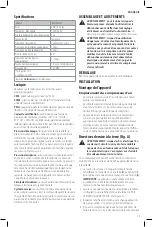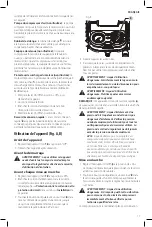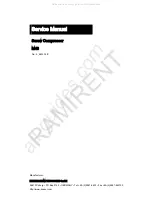
English
7
When performing maintenance, you may be
exposed to voltage sources, compressed air,
or moving parts. Personal injuries can occur.
Before performing any maintenance or repair,
disconnect power source from the compressor
and bleed off all air pressure.
Customer Responsibilities
Before each
use
Daily or after
each use
See tank
warning
label
Check Safety Valve
X
Drain Tank
X
Remove tank from
service
X
1
1– For more information, call 1–800–4-
D
e
W
ALT (1–800–433–9258)
nOTE:
See
Operation
section for the location of controls.
To Check Safety Valve (Fig. C)
WARNING: Risk of Bursting. If the safety valve
does not work properly, over-pressurization may
occur, causing air tank rupture or an explosion.
WARNING: Risk from Flying Objects. Always
wear certified safety equipment: ANSI Z87.1 eye
protection (CAN/CSA Z94.3) with side shields.
Before starting compressor, pull the ring on the safety
valve
7
to make sure that the safety valve operates freely. If
the valve is stuck or does not operate smoothly, it must be
replaced with the same type of valve.
Fig. C
7
To Drain Tank (Fig. A, D)
WARNING:
Risk of Unsafe Operation. Air tanks
contain high pressure air. Keep face and other
body parts away from outlet of drain. Use
ANSI Z87.1 eye protection (CAN/CSA Z94.3) when
draining as debris can be kicked up into face.
WARNING: Risk from noise. Always wear proper
hearing protection during use. Under some
conditions and duration of use, noise from this
product may contribute to hearing loss.
nOTE:
All compressed air systems generate condensate
that accumulates in any drain point (e.g., tanks, filter,
aftercoolers, dryers). This condensate contains lubricating
oil and/or substances which may be regulated and must be
disposed of in accordance with local, state, and federal laws
and regulations.
WARNING: Risk of Bursting. Water will condense
in the air tank. If not drained, water will corrode
and weaken the air tank causing a risk of air
tank rupture.
NOTICE:
Risk of Property Damage. Drain water
from air tank may contain oil and rust which can
cause stains.
1. Set the On/Off switch
4
to “Off”.
2. Turn the 1-Turn Regulator knob
8
counterclockwise to
set the outlet pressure to zero.
3. Remove the air tool or accessory.
4. Place a suitable container under the drain valve to
catch discharge.
5. Pull ring on safety valve
7
allowing air to bleed from
the tank until tank pressure is approximately 20 psi.
Release safety valve ring.
6. Drain water from air tank by opening drain valve
9
on
bottom of tank.
9
Fig. D
7. After the water has been drained, close the drain valve.
The air compressor can now be stored.
nOTE:
If drain valve is plugged, release all air pressure. The
valve can then be removed, cleaned, the reinstalled.
Cleaning
WARNING:
Blow dirt and dust out of all air vents with
clean, dry air at least once a week. To minimize the risk
of eye injury, always wear ANSI Z87.1 approved eye
protection when performing this.
WARNING:
Never use solvents or other harsh
chemicals for cleaning the non-metallic parts of
the tool. These chemicals may weaken the plastic
materials used in these parts. Use a cloth dampened
only with water and mild soap. Never let any liquid
get inside the tool; never immerse any part of the tool
into a liquid.
Repairs
WARNING:
To assure product SAFETY and
RELIABILITY, repairs, maintenance and adjustment
(including brush inspection and replacement, when
applicable) should be performed by a
D
e
WALT
factory
service center or a
D
e
WALT
authorized service center.
Always use identical replacement parts.










































